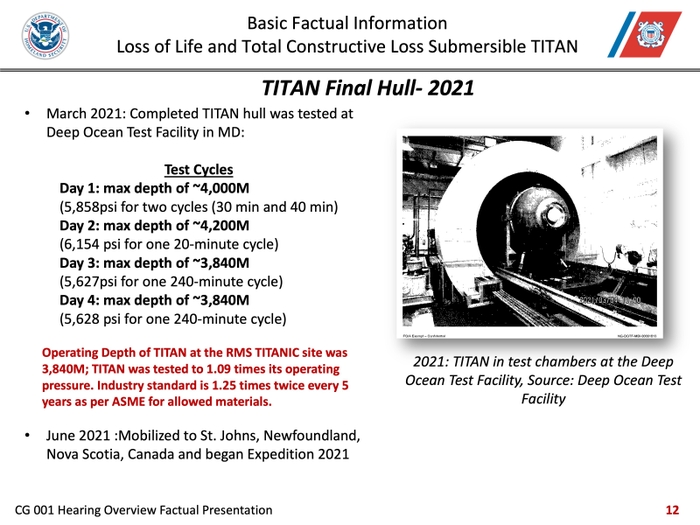Coast Guard OceanGate Sub Investigation Reveals Haphazard Construction
Sep 25, 2024
Coast Guard OceanGate Sub Investigation Reveals Haphazard Construction
U.S. Coast Guard investigation hearings into the implosion of the tourist submersible Titan, operated by OceanGate Expeditions at the site of the sunken RMS Titanic detailed shortcuts in the sub’s construction that apparently combined to sink it during a visit to Titanic in 2023.
“We all voiced concerns about what was happening in terms of the engineering of Titan and even more so when the components started arriving at the facility during 2017,” testified former OceanGate operations director David Lochridge. “It was inevitable something was going to happen. It was just, ‘when?’”
At the time of the accident, popular opinion quickly indicted OceanGate for the unorthodox use of carbon fiber for Titan’s hull. But carbon fiber pressure vessel specialist Composite Energy Technologies (CET), a supplier of pressure vessels to customers such as the Office of Naval Research has never had a failure of one of its hulls in uncrewed dives deeper than Titan, according to president Chase Hogoboom.
Titan’s original design was all carbon fiber. But after one-third-scale models suffered failures, OceanGate pivoted to titanium for the reinforcing rings and for the domes at the ends of the pressure vessel. The Coast Guard found that OceanGate operated a prototype version of Titan on multiple dives when the vessel suffered cracks in the carbon fiber hull.
Related:Carbon Fiber Is Safe for Submersibles When Properly Applied
For the final hull, contractor Janicki Industries cured the laid-up carbon fiber in its autoclave after every additional inch of thickness for improved strength. OceanGate reinstalled the prototype’s titanium domes and rings on the final hull for paying passenger service.
The result was a pressure vessel that was tested to 1.09 times the anticipated pressure at the depth of the Titanic, a thinner margin of safety than expected. The ASME standard is to test at 1.25 times the anticipated maximum pressure twice every five years.
For its uncrewed carbon fiber pressure vessels, CET not only tests the design to destruction but proves each one at 1.5 times the anticipated maximum pressure, according to Hogoboom. “1.09 factor of safety seems low for manned vehicles,” he said in an email to Design News. “Our standard is 1.5 for unmanned… We do other work for theme parks, for that, the requirement is 6… In both cases, actual testing needs to demonstrate that performance, not just computer modeling.”

U.S. COAST GUARD
These are the things that led RMS Titanic expedition leader G. Michael Harris to state in a television interview with NewsNation, “There is a right way and a wrong way of doing things and (OceanGate founder) Stockton (Rush) did everything wrong.”
Related:Why Did the Fury 325 Roller Coaster Break?
“It was strictly a matter of time,” he said. “We all knew it.” Harris says that he warned his friend Paul-Henri Nargolet, who died in the accident, not to dive on Titan.
“This man, Stockton Rush, was a complete, unequivocal narcissist, and in the end, a murderer,” Harris charged. “He killed those people. He knew better. The board of directors knew better. The employees of the company knew better. The attorneys knew better. They all should have said something.”

Titan's last message, indicating that it had dropped two weights to slow its descent as it neared the bottom, came at a depth of 3,346 meters, where the pressure registered 4,900 psi. U.S. COAST GUARD
Former OceanGate contractor Tym Catterson worked on the recovery, where he saw the debris firsthand. Based on the damage he saw, Catterson told the Coast Guard that he believes that Titan failed at the glue line between the carbon fiber hull and the forward titanium dome. “Cyclic fatigue of the glue,” he concluded.
The carbon fiber hull flexed under compression during dives, bending it at the interface with the titanium domes, Catterson hypothesized. This repeated flexing degraded the glue over time until the seal failed according to his theory.
The Coast Guard report indicates that the adhesive OceanGate employed was its own concoction.